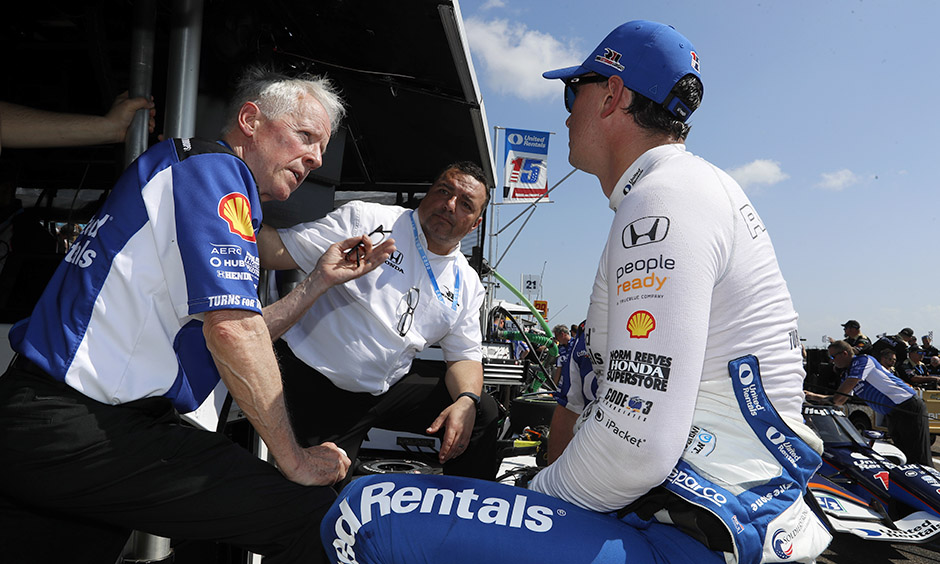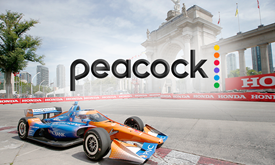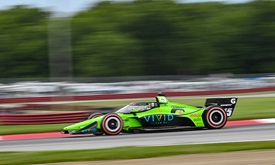The Setup: Toronto with Eddie Jones
JUL 11, 2023
Note: This is a continuing series for INDYCAR.com, with different guests, leading into each race weekend for the NTT INDYCAR SERIES, focusing on various technical challenges of each respective circuit.
The 10th round of the 2023 season for the NTT INDYCAR SERIES goes north of the border for the Honda Indy Toronto. A 1.786-mile, 11-turn (four left, seven right) temporary street circuit at Exhibition Place is equipped with a long frontstretch leading into the Princes' Gate at Turn 1 before some challenging corners, including a 90-degree right-hander at Turn 3 at the end of the sprint down Lakeshore Boulevard.
There will be two practice sessions and an NTT P1 Award qualifying bout ahead of the race day morning warmup. Coverage for the 85-lap (151.81 miles) race will begin at 1:30 p.m. ET Sunday, July 16 (Peacock, INDYCAR Radio Network).
The qualifying record on this track configuration length is held by Josef Newgarden, who threw down a flying lap of 58.4129 seconds (110.072 mph) in 2019.
This week’s featured guest is Eddie Jones, race engineer for Graham Rahal’s No. 15 Rahal Letterman Lanigan Racing Honda. Rahal finished fourth last season at Honda Indy Toronto after starting 14th.
Q: What is it like preparing for a race on the streets of Toronto?
Eddie Jones: All the street courses are really quite unique. They're a real challenge. They require controlled aggression from the drivers. You're going at high speed between walls, barriers, each side of you. Generally, in preparation for any event, we look at the previous year's performance. Then, we look at what developments we've done with the car, with the various systems, be it damping, suspension since then, be it in testing or in this case at previous street course events. And then we look at what's perhaps appropriate to employ from those developments for this year's event. We did quite well at Toronto last year, but from our perspective, it was still not good enough. So, we take a very good look at last year's setup and how we progressed through the weekend. Collectively, as an engineering group, we will look at areas we feel we need to improve on, can improve on. We'll run various simulations to predict the increased performance, and then, ultimately, we'll arrive at what we believe our start setups will be. Toronto is really quite bumpy in several areas. It's quite a bumpy braking zone, for instance, into Turn 1 and Turn 8. There are also a couple of quite heavy curb strikes at the apex of one or two of the corners. They can be particularly difficult to deal with. Take into Turn 1, where you're braking from quite high speed in a very bumpy brake zone and then entering a corner that has -- I'm sure is still the case -- a sort of slippery concrete patch at the apex. So, these present us with real challenges. There's an emphasis on how the damping manages those inputs from the bumpy brake zone change of surface inside curb. So, quite a lot to contend with. Toronto, a typical street course, but the Toronto setup will be very different, for instance, from an Indy (Indianapolis Motor Speedway) road course or a (WeatherTech Raceway) Laguna Seca. You know, permanent road course-type setup.
Q: Would Toronto be classified as the weirdest track surface blended with the bumpiest track surface that forces you to go softer with the suspension and raising the ride heights to a level that maybe we don't see at another street events?
Jones: Yeah. Certainly as a general trend, it's correct what you're saying. Funny you should say, that just reminds us of Detroit this year, which was quite a different track and presented all sorts of issues for everyone, but particularly for us, unfortunately to say. But, yes, generally speaking, the bumpier of the track, you have to deal with those bumps. You can't bottom the car too hard, not just because obviously it's upsetting to the driver, but ultimately you can really damage the underside of the car. So yes, the bumpier the track, the more undulating rough surface, you do have to accommodate that and generally, that tends to be toward the softer side of suspension, and the damping control is very important there; being able to ride the bumps and at the same time maintain control of the car's transitions. It's challenging, for sure. All tracks are in their own way, but yes, Toronto is uniquely challenging I find, but at the same time extremely rewarding when you do well there.
Q: At Toronto, when you're trying to develop grip for the tires to help with the balance, does that circuit favor more of a mechanical grip over aerodynamic grip?
Jones: Certainly that's the case at Toronto. Obviously, aero, we will always take more downforce if we can get it, but I think you'll find that all cars at that event are going to be max downforce. So, we are really searching for mechanical grip. That's the primary focus in the race. With the long back straight at Toronto, it's sometimes desirable to trim a little, reduce the drag for the race situation to enable overtaking. It'll be interesting to see this year if we feel that a consideration because year to year we go back to these same places, there can be more deterioration of the track surface. It may not have quite the same grip it had last year. At the same time, there may be an area that's been resurfaced and has more grip. Before the event starts, we have a track walk around each of the tracks, so we refer to our previous year's reference as to whether there have been any changes to the track, either surfaces, curbing, new bumps. So, that's all taken into account in our final appraisal of our start setups.
Q: What is the trickiest part to set up for?
Jones: That's a tough one. Each section of Toronto has its own challenges. For instance, the bumpy brake zone at Turn 1 and then the sort of low-grip concrete surface at the apex, that's a crucial corner because it leads onto the very long back straight. That's just one corner, but very important. Whereas the final section of the track where it's Turn(s) 9, 10, 11 – left, right, left – onto the pit straight, obviously it's connected, it's flowing, the car has to have good change of direction through that whole section and then be good onto the front straight. Two very different sections there; Turn 1 just as a specific corner and then the 9, 10, 11, which is connected but also crucial for time. And then as we go to the end of the back straight, Turn 3, which is from a very high-speed straight to getting the car really slowed up for the very tight Turn 3 right-hander that goes rather back on itself. Once again, slippery, low-grip surface, slow corner, low gear, there's a real premium on traction out of that corner to get you up the hill. You go slightly uphill there from Turn 3 up through the kink of (Turn) 4 and onto Turn 5. So, that corner really requires good rotation and good traction. Then, you lead into Turn 5, which is a left-hander that has a quite high curb at the apex, which ideally for the line through there you would like to use but it's quite difficult because it is a high curve. It's quite disturbing when the car strikes it. So once again, right there is a unique challenge. And as you go through Turn 5, you then set up for the long, sweeping right-hand Turn 6. So, getting through Turn 5 is very important and not to be too far to the outside at the exit of 5 because you need to be over the left-hand side to set up Turn 6. And then Turn 6, itself, very long duration sweeping right-hander where there's a lot of time. A car that doesn't have a good balance through there, whether it's understeer or oversteer or both, there's a lot of time to be had there. That's really quite important. Then, you come into the Turn 8 90-degree (corner), right-hander, once again very rough surface, bumpy braking zone. In qualifying, the end of lap beacon is just at the exit of that corner. So, certainly in qualifying all the drivers attempt to, what they feel is their best lap, they really launch it into that turn and try to get just to the timing beacon with the most momentum they can carry. Again, it's a difficult turn, bumpy brake zone, high curb on the inside that you'd like to use some of just for the tighter line, but your car has to be able to do it. So, there we are. I've sort of gone through a lap, really. It's a tough place. Very challenging.
Q: What is the challenge of keeping the balance of the car over the length of an entire stint during the race?
Jones: What you're factoring in there is tire degradation. There are two things there, really. The balance that you just alluded to. If you have, for instance, too much understeer, you are going to eventually hurt your front tires, you're wearing them too much. Conversely, too much oversteer or a car that's too loose or the traction's very poor, a lot of wheels spin, you will degrade the rear tires rapidly. Certainly, the better the balance, the more chance you have. And then just tire degradation itself, the easier the car is on the tires, the more desirable that is for your car to perform well over the full stint. That's something we look at closely as we prepare for the race because dealing with longer stints. Just general compliance looking after the tire and then maintaining a good balance through the stint is very important. Toronto, there's a lot of slow corners, high acceleration from slow corners on low-grip surfaces. So, there's a premium on traction at that track, in my opinion.
Q: Each driver has a different style of preferred setup. Obviously, a neutral balance is so tough to find. When it comes to Graham, would you say that he prefers more understeer or oversteer, and which one is a little bit better fit for his wheelhouse?
Jones: They're all adaptable. They're all very talented in this series. Graham, he really is a late, hard braker. To enable him to carry that style, we really need to secure the rear of the car on entry, in particular. When we do that, his performance is terrific. So, I would tend to say he's less keen on oversteer than he is on understeer.



















